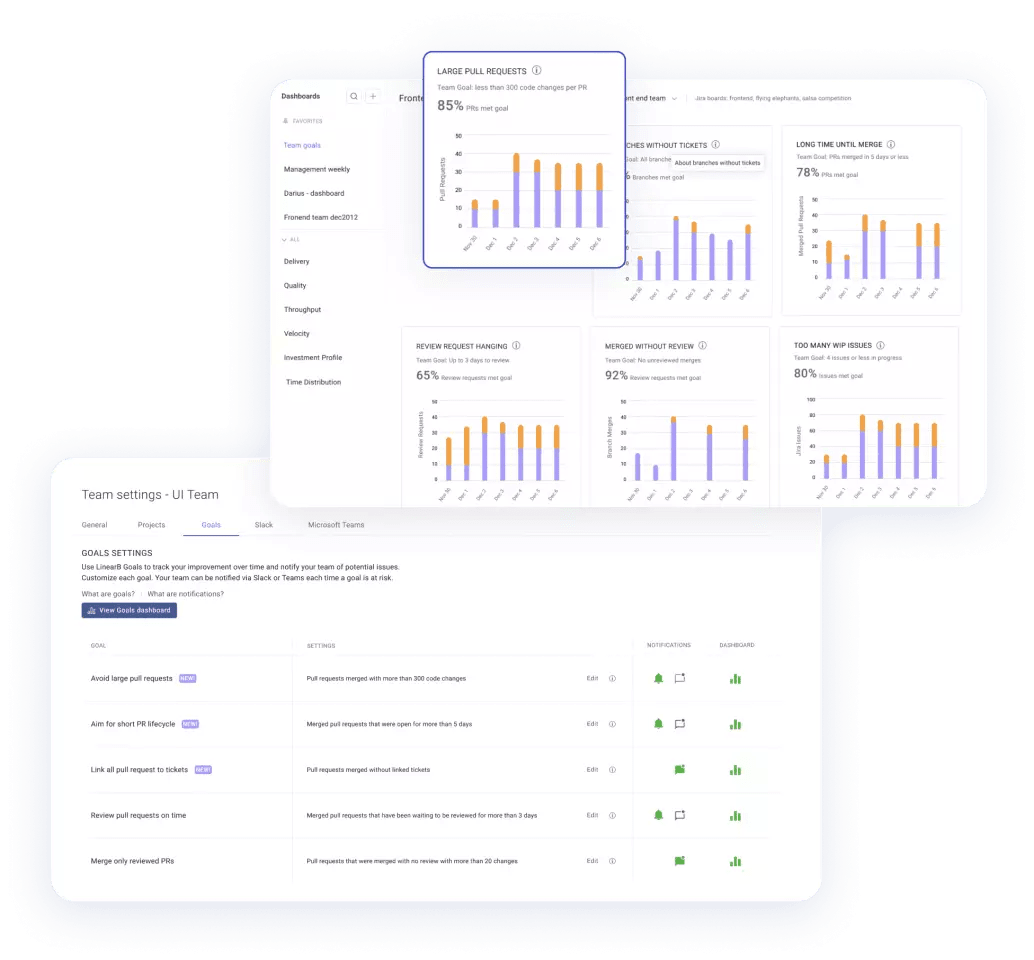Businesses have evolved…like a lot. Leadership no longer has to rely on gut instincts alone to make big decisions. Now, we have cool things like charts and dashboards to oversee software development, instead of punch cards and archaic engineering methods like Waterfall.
You have to rely on hard data to make smart decisions that move your business forward, but you’re probably so overloaded with data by now that you don’t know what’s good and what isn’t. And when it comes to software development, it can be a struggle to quantify teams’ efficiency and identify their bottlenecks. So how you can maximize their productivity?
Thankfully, you don’t need to worry about that anymore. With an engineering management platform, you’ll have the right data at your disposal and know how to use it for good. But what exactly are engineering management platforms, and what do they provide? Let’s dive in and find out!
Table of Contents
- Engineering Management Platforms Defined
- 3 Pillars of an Engineering Management Platform
- How Does an Engineering Management Platform Work?
- How to Manage an Elite Engineering Org
Engineering Management Platforms Defined
An engineering management platform (EMP) is a tool that provides visibility into your engineering organization, including how your teams are investing time and resources, your overall efficiency, and progress on key deliverables.
These platforms help engineering leaders like you make informed decisions and visualize all aspects of your engineering organization. This can include DORA metrics, other important engineering benchmarks, and custom dashboards to give you all the information you need in one central location.
Armed with the knowledge and data you’ve gathered, you can then identify and resolve bottlenecks in your development process and monitor how your teams are doing with real, quantifiable data. And with that, you can keep other execs informed on what your engineering org is up to and how they’re doing.
3 Pillars of an Engineering Management Platform
A good engineering management platform has three pillars that correspond to the key responsibilities of your role and all levels of your organization. When choosing your platform, look for features that align with these three pillars.
1. Developer Experience
Developer experience (DX) refers to how frictionless it is for developers to accomplish their work, whether it’s changing the system or creating something new from start to finish. Your devs will be more productive if you improve their workflows, processes, and working environment.
Using engineering project management software to monitor DX will highlight ways to improve the developer experience. And this way, you and your team leaders can better cater to developers’ needs.
Here are some key things to look for in an engineering management platform:
- DX metrics, like WIP, active days, and merge frequency
- WIP investigation
- Continuous merge tools, like gitStream
2. Engineering Tempo
To make informed decisions, you and your managers need to have a bird’s eye view of your teams’ performance, their standing in the industry, and the areas that require improvement. You’ll need to collaborate with your team leaders to establish objectives and monitor performance, and you’ll want to share success stories with the company.
But your team leaders need to go deeper to pinpoint bottlenecks and collaborate with their teams to establish and monitor targets for improvement. And your developers may require working agreements and tools to ensure they’re following best practices.
The right EMP will not only track your engineering tempo but help you improve it, which means your org will be able to ship more features faster.
Key things to look for include:
- DORA & flow metrics, such as cycle time
- Bottleneck detection
- Team improvement tools, like WorkerB
3. Business Alignment
The third, but certainly not least, pillar is business alignment. Business alignment ensures that your engineering org is moving in the right direction, i.e., the direction that aligns to larger business objectives.
This means your EMP should help you track where your engineering resources (time and people) are being allocated and use that data to have more transparent and productive strategy negotiations.
And this will improve your project forecasting and sprint planning to ensure you deliver on your promises.
When engineering delivers on time, positive effects ripple through the entire company. Marketing campaigns can be designed and launched. Executives can more confidently commit to revenue targets. New features can be promised to clients, and deals can be signed.
An EMP should easily uncover the information you need to guide your decisions on resource allocation and project forecasting.
Key things to look for:
- Project investment
- Project forecasting & planning accuracy
- Cost capitalization reporting
Check out this video from our co-founders Ori Keren and Dan Lines discussing the three pillars of Developer Experience, Engineering Tempo and Business Alignment:
How Does an Engineering Management Platform Work?
Any good engineering management platform should follow a three-step recipe to ensure you get the key insights you need.
1. Benchmark Your Metrics
First, you need to get an idea of how your teams are already performing. If you use Engineering Metrics Benchmarks to get a glimpse of your org’s productivity at the start, you’ll be able to spot inconsistencies in your workflows from the get-go.
For example, LinearB helps you see your org’s cycle time and planning accuracy, so you’ll get an idea of their overall tempo and alignment. Metrics like these can show you any potential bottlenecks in teams’ workflow.
And now that you’re equipped with complete, accurate data, you can start making plans to wipe out bottlenecks and help your teams be more efficient.
2. Set Team Goals
After you’ve gathered all that data, it’s time to put it to work. Setting goals for an entire team allows them to work together to improve. And it gives them clear goals to grow and get better at what they do.
For example, one area that might need improvement is your review time. It’s something that we see all the time as a common pain point for development teams, so we’ve baked it into our EMP.
Let’s say one of your teams is struggling with PRs sitting idle for up to two or three days before being reviewed. Your teams can set a Team Goal to ensure all their PRs in the next sprint are picked up and reviewed within 18 hours, and your team leaders can track that with our Team Goals dashboard.
With Team Goals in place, you’re empowering your dev teams and team leaders with clear-cut objectives. You’re also giving them accountability if they miss their marks.
 Track progress by sprint, week or month so you can celebrate team improvement regularly. Let your team have cake! Book a demo of LinearB today.
Track progress by sprint, week or month so you can celebrate team improvement regularly. Let your team have cake! Book a demo of LinearB today.
3. Automate Improvement
Instead of letting your developers waste time doing tiresome, repetitive work, the best EMPs bless them with automation. And this doesn’t just make devs’ lives easier — it speeds up and smooths out the entire development process. That’s why we believe automation is the foundation for truly better engineering.
And one thing that can use automation is your PR process. Sure, you can speed up manual reviews with Team Goals, but what if you could take things to the next step? That’s what LinearB’s gitStream does! You can use it to set custom rules for review automations and auto-route PRs based on these rules.
For example, you can use gitStream to have small, insignificant changes automatically reviewed and merged, while larger — or more critical — ones can be routed to the right person for review. And now, your devs won’t ever have to wait four days just for a thumbs-up emoji on a PR.
We can also eliminate some of the context switching that comes along with the PR review process by integrating it into the rest of your team’s workflows. Our developer bot, WorkerB, allows your teams to save time by adding context to PRs in real time to navigate the queue. It even enables reviewers to approve PRs with less than five lines of code within Slack or MS Teams.
Check out this discussion between LinearB CEO, Ori Keren, and Dev Interrupted community leader Conor Bronsdon, where they dive into all things WorkerB!
This data-driven, developer-centric method of automating engineering improvement helps you establish truly autonomous, continuously improving dev teams.
How to Manage an Elite Engineering Org
All too often, you lack the information you need to fully comprehend and maximize your engineering teams, let alone use that knowledge to make smarter business decisions. Here’s where EMPs can help. Using them as a lens, you can strategically show your colleagues how much of an impact your engineering org has. You’ll also be able to address the technical hurdles of developing a data-driven strategy for operational success.
The field of engineering management is on the threshold of a new era of analytics and insights driven by data. We’ve all seen how customer relationship management (CRM) and marketing automation (MA) have transformed sales and marketing departments into data-driven decision-making powerhouses. And EMPs will also play a key role in changing engineering leadership roles. Engineering management platforms like LinearB allow you to direct your teams’ efforts where they’ll most significantly impact business outcomes.
 Want to improve your engineering processes at every level? Get started with a LinearB free-forever account today!
Want to improve your engineering processes at every level? Get started with a LinearB free-forever account today!




